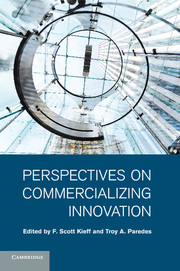Book contents
- Frontmatter
- Contents
- Contributors
- Dedication
- Acknowledgments
- Introduction
- Part I Perspectives on Theories of Intellectual Property
- Part II Perspectives on the Problems of Anticommons and Patent Thickets
- Part III Perspectives on Finance and Commercialization
- Part IV Perspectives on the University Innovation
- 13 University Software Ownership and Litigation
- 14 The Impact of the Bayh-Dole Act on Genetic Research and Development
- 15 Patents, Material Transfers, and Access to Research Inputs in Biomedical Research
- 16 Are Universities Patent Trolls?
- Part V Perspectives on International Considerations
- Index
- References
15 - Patents, Material Transfers, and Access to Research Inputs in Biomedical Research
from Part IV - Perspectives on the University Innovation
Published online by Cambridge University Press: 05 December 2011
- Frontmatter
- Contents
- Contributors
- Dedication
- Acknowledgments
- Introduction
- Part I Perspectives on Theories of Intellectual Property
- Part II Perspectives on the Problems of Anticommons and Patent Thickets
- Part III Perspectives on Finance and Commercialization
- Part IV Perspectives on the University Innovation
- 13 University Software Ownership and Litigation
- 14 The Impact of the Bayh-Dole Act on Genetic Research and Development
- 15 Patents, Material Transfers, and Access to Research Inputs in Biomedical Research
- 16 Are Universities Patent Trolls?
- Part V Perspectives on International Considerations
- Index
- References
Summary
Introduction
As patenting of both the inputs and outputs of scientific research have become more common, policy makers are faced with the question of whether introducing patenting into the system of scientific rewards is hurting or helping the causes of scientific and technological progress. The impact of patent protection on the research conducted in public research institutions – namely universities, government labs, and nonprofit organizations – is not well understood. This issue has taken on increasing importance since the combined events of the passage of the Bayh-Dole Amendment in 1980 and related legislation encouraging institutions to patent findings from research supported by public funds; the 1981 Diamond v. Chakrabarty court decision affirming the patentability of life forms; and the revolution in molecular biology, combinatorial chemistry, bioinformatics, and related fields that has spawned discoveries of enormous commercial value since the 1970s.
Scholars have recently argued that patents may now impose significant costs upon upstream, noncommercial research. Heller and Eisenberg (Heller and Eisenberg 1998) suggest that the patentability of a broad range of the inputs that researchers need to do their work may give rise to an anticommons or “patent thicket” that may make the acquisition of licenses and other rights too burdensome to permit the pursuit of what should otherwise be scientifically and socially worthwhile research (cf. Shapiro 2000). Merges and Nelson (1990) and Scotchmer (1991) highlight the related possibility that, in some domains, the assertion of patents on only one or two key upstream, foundational discoveries may significantly restrict follow-on research. A further concern is that the prospect of realizing financial gain from upstream research may increase researchers’ reluctance to share information or research materials with one another, thereby impeding the realization of research efficiencies and complementarities. Similarly, researchers may be trading away rights to conduct future research or to freely disseminate their discoveries in exchange for current access to research inputs or financial support (Cohen, Florida, and Goe 1994; Thursby and Thursby 1999). Finally, prospective financial gains from the exploitation of intellectual property (IP) may induce researchers to choose research projects on the basis of commercial potential rather than scientific merit.
- Type
- Chapter
- Information
- Perspectives on Commercializing Innovation , pp. 489 - 530Publisher: Cambridge University PressPrint publication year: 2011
References
- 3
- Cited by



